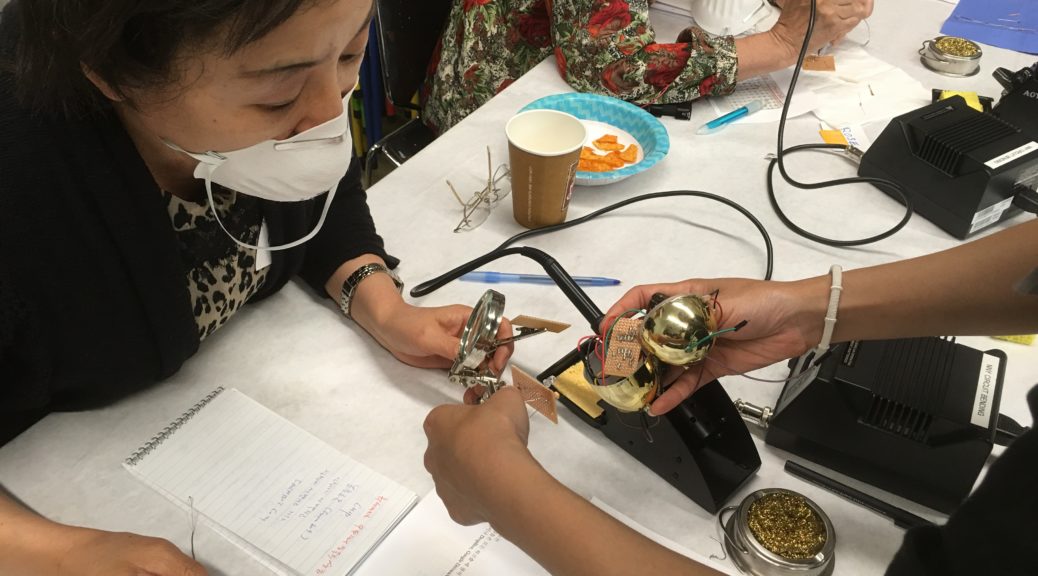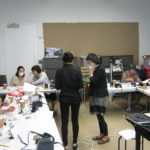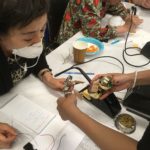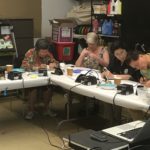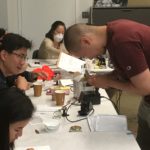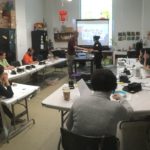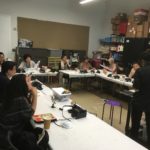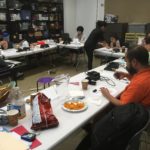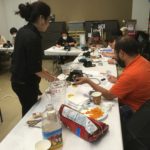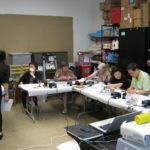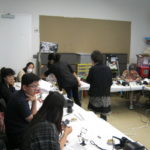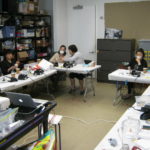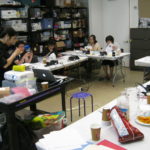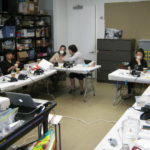In week two, participants learned about STEM and STEAM education and the importance of art education in contexts of cultural as well as social development. In Untitled print from 1973, Nam June Paik asked

- How soon TV-chair will be available in most museums?
- How soon will artists have their own TV channels?
- How soon wall-to-wall TV for video art will be installed in most homes?
We discussed the current examples that functioned like the objects he described. The list went on – Photobooth Kiosk, Cellphone selfie, iPad interactive learning tool, Podcast, self-publishing website, Youtube, Vimeo, and Digital picture frame. Park’s untitled piece was one of the examples how could art brings potentialities for unknown future. Ken Okiishi’s painted flat TV called Gesture/Data, 2013 brought out the idea that emotional intelligence machine is no longer a science fiction. The actual painted abstract expressionistic brushstrokes covered a representational image emitting from the screen. The vertical orientation is also referencing the intimacy inherent to a portraiture. This physical flatness expresses emotion.
Earlier in the class, we introduced each other and shared what motivated them to take this workshop. They were curious to know a concept of sound in visual art, and how do interactive artworks operate which they had seen in museums and galleries. We looked at specifically women artists with technology who use electronics and sound to get their ideas across to viewers – Roopa Vasudevan, Jung-In Jung, Jayoung Chung, and Sam Lewitt who turned invisible energy to visible number through custom-designed flexible copper heating circuits.
We also looked at more utilitarian projects by individual makers. From Farmbot, $9 Computer, Bluetooth smart device and $60 DIY home laser cutter, these inventions ensued from the open-source culture which eventually intervened mass market price structure, consumer behavior, and value system.
We finished the STEAM presentation with 5000 years old concept from Gojoseon dynasty which is also Korean National education philosophy. 홍익인간 (Hong-Ik-In-Gan) is composed of Chinese characters WIDE, BENEFIT and MANKIND.
We made our first interactive circuit during the lab time. With 2.2K Ωhm resistor, LED, and Photocell, we soldered each part made a circuit that controls the brightness of LED based on the amount of light coming into the Photocell. Soldering is not a ubiquitous activity. They struggled when connecting two soldered parts though they learned fast with curiosity.
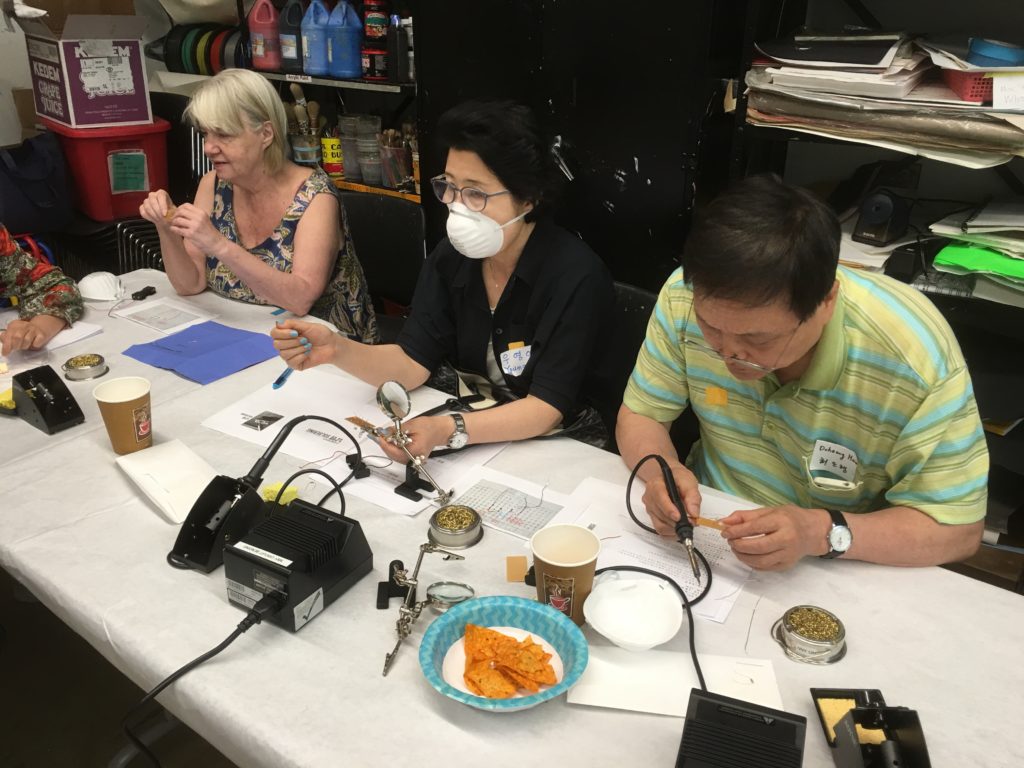
둘째 주에는 STEM과 STEAM 교육의 정의와 사회 문화적 발전에 미술의 관여성을 주제로 시작하였다. 1973년 백남준 작가의 작품, 무제는 우리에게 3가지 질문을 던진다.
- 얼마나 빨리 TV-chair 대부분의 박물관에서 출하 가능 할까?
- 어떻게 곧 예술가들이 자신들만의 TV채널을 가지게 될 것인가?
- 어떻게 곧 비디오 예술이 대부분의 가정의 TV에 설치될 것인가?
우리는 백남준이 기대하는 이 미래의 오브제를 현시대에서 찾아 제시 해 보았다. 그가 말하는 TV-Chair는 우리생활에 이미 만연해 있다. – 포토부스 키오스크, 휴대 전화 셀피, iPad 대화형 학습 도구, 팟 캐스트,유튜브, 비메오,디지털 액자, 웹 사이트. 백남준의 이 작업은 미래의 무궁 무진한 가능성을 예술을 통해 유추 가능하다는 것을 보여주었다. 켄 오키쉬의 평면 텔레비전 Gesture/Data, 2013 감정적인 지능 머신의 아이디어는 더 이상 공상 과학에만 등장하는 이야기는 아니다. 실재 스크린 위에 색을 입힌 추상적 붓터치의 표현이 이 작업에서 이루어지며, 회전되어 설치 된 스크린은, 초상화의 감상에 익숙한 관람객에게 친밀감을 준다. 즉, TV가 단순 대상을 표현하는 것만이 아닌 감정도 담고있음을 보여주는 한 사례가 될 것이다.
참가자들의 워크숍 참가 동기를 공유하고 서로를 소개했다. 그들은 소리가 시각 예술에 관여하는 이유를 궁금 해 하는 동시에, 박물관과 갤러리에서 전시되어있는 인터렉티브 작품의 작동원리를 알고싶어했다. 우리는 특별히여성 예술가들 예로 들어가며 어떻게 기술이 미술을 통하여 표현되는 지 Roopa Vasudevan,Jung-In Jung, Jayoung Chung, 과 Sam Lewitt 의 보이지 않는 에너지를 구리 가열 회로를 통해 구현한 작품을 감상했다.
우리는 또한 개인적인 제작자들로부터 더 실용적인 프로젝트를 보았다.Farmbot부터 $9 Computer, 블루투스 스마트 장치에서 60달러 DIY 레이저 절단기등 이러한 발명품들은 오픈 소스문화를 바탕으로 일어나 결국에는 대량 판매 시장 가격 구조, 소비자 반응 과 가치 체계의 변화를 촉구하고 있다.
우리는 고조선 왕조 시대의 5000년의 개념이자 한국 국가 교육 철학인 홍익인간으로 발표를 마쳤어.홍익인간(Hong-Ik-In-Gan)한자 WIDE, BENEFIT과 MANKIND로 구성되어 있다.
이번주 실습은 인터렉티브한 전기기기를 만들어 보기로 했다. 참가자들으 각 한쌍의 2.2KΩhm 저항기, LED, Photocell을 가지고 환경안의 빛의 밝기에 따라 반응하는 회로를 만들었다. 남땜질이 워낙 익숙치 않지만 모두들 호기심을 가지고 빨리 습득하셨다. 실재로 두 납떔질한 부분을 연결하는 부분에서 다소 어려움이 있었지만 예제를 보며 곧 그 요령을 터득하셨다.

